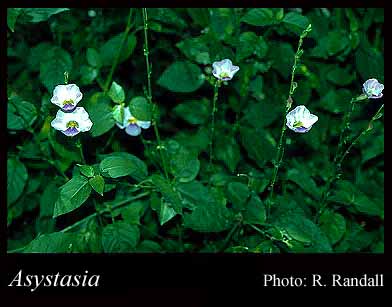- Reference
- Bijdr.Fl.Ned.Ind. 796 (1827)
- Name Status
- Current

Scientific Description
Family Acanthaceae.
Habit and leaf form. Shrubs, or herbs (with dot-like cystoliths). The herbs annual to perennial; plants with neither basal nor terminal concentrations of leaves. Hydrophytic, or helophytic, or mesophytic, or xerophytic. Leaves opposite (pairs connected by transverse ridge); petiolate; gland-dotted, or not gland-dotted; simple. Leaf blades entire; flat; pinnately veined, or palmately veined; cross-venulate. Leaves without stipules. Leaf blade margins entire. Stem anatomy. Nodes unilacunar. Secondary thickening developing from a conventional cambial ring. Roots. Aerial roots present, or absent.
Reproductive type, pollination. Fertile flowers hermaphrodite. Unisexual flowers absent. Plants hermaphrodite. Entomophilous. Pollination mechanism conspicuously specialized, or unspecialized.
Inflorescence and flower features. Flowers aggregated in ‘inflorescences’; in racemes (the flowers single or paired). The terminal inflorescence unit cymose, or racemose. Inflorescences terminal, or axillary. Flowers bi- bracteate. Bracts small. Flowers bi- bracteolate. Bracteoles similar to bracts. Flowers regular, or somewhat irregular; zygomorphic; 5 merous; tetracyclic. Free hypanthium absent. Hypogynous disk present; annular. Perianth with distinct calyx and corolla; 10; 2 -whorled; isomerous. Calyx 5; 1 -whorled; gamosepalous (basally); lobed; more or less regular; with the median member posterior. Corolla 5; 1 -whorled; gamopetalous; imbricate; funnel-shaped; more or less regular, or unequal but not bilabiate (the abaxial member with a palate ? in form of longitudinal fold). Androecium 4. Androecial members adnate; all equal, or markedly unequal; free of one another, or coherent; 1 -whorled. Stamens 4. Staminal insertion in widened part of corolla tube, in pairs. Stamens remaining included (usually), or becoming exserted; when unequal didynamous; reduced in number relative to the adjacent perianth; oppositisepalous; all alternating with the corolla members. Anthers dorsifixed; dehiscing via longitudinal slits; bilocular; tetrasporangiate; appendaged (with a small awn just above base), or unappendaged. Pollen shed as single grains. Gynoecium 2 carpelled. The pistil 2 celled. Gynoecium syncarpous; synstylovarious to eu-syncarpous; superior. Ovary plurilocular; 2 locular. Gynoecium median. Ovary sessile. Styles 1; attenuate from the ovary; apical; much longer than the ovary at anthesis. Stigmas 1; 2 - lobed; dry type; non-papillate; Group II type. Placentation axile. Ovules 2 per locule; non-arillate, or arillate; hemianatropous, or anatropous, or campylotropous.
Fruit and seed features. Fruit non-fleshy; dehiscent; a capsule (clavate, basal part lacking seeds). Capsules loculicidal. Fruit elastically dehiscent. Dispersal unit the seed. Fruit 2 seeded, or 4 seeded. Seeds compressed, more or less triangular with angled margins; non-endospermic; not conspicuously hairy. Embryo well differentiated. Cotyledons 2. Embryo achlorophyllous; curved. Testa smooth, or with tubercles. Seedling. Germination phanerocotylar.
Physiology, biochemistry. Aluminium accumulation not found.
Special features. The seeds on elongated, indurated, hook-shaped funicles (‘retinacula’).
Geography, cytology, number of species. Native of Australia. Not endemic to Australia. Australian states and territories: Western Australia and Queensland. Northern Botanical Province.